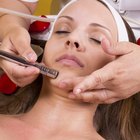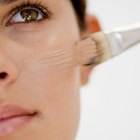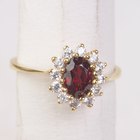
While dark circles under the eyes are generally not harmful to your health, they are a frequent cosmetic concern for many people. Not only are these under eye circles aesthetically unpleasant, but they can also add years to your appearance or make you look tired or unhealthy. Kojic acid is an increasingly popular treatment for this skin condition.
Identification
Kojic acid is a natural skin-whitening agent that was originally identified in Asia as a component of Japanese rice wine (sake). According to G. A. Burdock, kojic acid is naturally produced by various species of fungi, including Penicillium, Acetobacter and Aspergillus. It is also artificially produced biologically through a process of fermentation, hence its name “kojic,” which is derived from the Japanese word “koji,” which means “culture,” according to Face Works. It is widely used in treatments for pigmentary skin disorders.
Dark Circles
Dark circles, which are medically referred to as infraorbital dark skin, are circular-shaped areas of dark discoloration that tend to form beneath the eyes, according to the Mayo Clinic. They are caused by allergies, heredity, pigmentation irregularities and the process of aging.
Function
Kojic acid offers a natural alternative to more invasive medical treatments such as laser therapy and surgery in getting rid of dark circles. It is a widely used component in skin-bleaching products, serving as a biologically active skin-lightening agent. Kojic acid is often available in topical formulations such as creams, lotions and soaps.
Mechanism of Action
According to Nico Smit at the Leiden University Medical Center in the Netherlands, the skin whitening properties of kojic acid work by hindering the process by which melanin is produced (See Reference #4). In a report published in the International journal of molecular sciences , they explain that melanin is a natural skin pigment that is responsible for the color of a person’s skin. By reducing the amount of melanin that is produced, kojic acid gradually fades dark circles away.
Considerations
According to C.B. Lynde at the University of Toronto’s Faculty of Medicine, although kojic acid is generally equivalent to other treatments for dark circles such as Azelaic Acid, Hydroquinone and retinoids, it can be more irritating to your skin. In a report published in "Skin Therapy Letter," it is noted that kojic acid may, however, be an effective alternative if you have trouble tolerating other first-line therapies.
Related Articles

Definition of Skin Bleaching

Hydroquinone & Dark Circles

What Prescriptions Can Get Rid of Under ...

List of Retinoids

Fraxel Laser Treatment Dangers

Chasteberry for Acne

Can Age Spots Be Reversed?

Amino Acids to Get Rid of Acne Scars & ...

Skin Care Products That Contain ...

Can Tri-Luma Be Used to Fade Acne Scars?

Chinese Remedies for Lines & Wrinkles

Ingredients in Maybelline Foundation

What Are the Benefits of Ashwagandha in ...

Negative Side Effects of Paba

Homeopathy Cure for Stretch Marks

The Difference Between Retin A & Renova

Aggressive Behavior in Adults

Is Proactive Too Strong for Sensitive ...

Physical Characteristics of the Ruby ...

Benefits of Shea Butter and Coconut Oil ...
References
Writer Bio
Based in Blue Springs (MO), the ArmChairGeek has worked as a freelancer since 2007. An alumni of the University of California, San Marcos, he specializes in writing health-related eBooks, articles and other web content for a number of websites, including Demand Studios, eHow and WiseGeek.
Photo Credits
eye image by Stanisa Martinovic from Fotolia.com